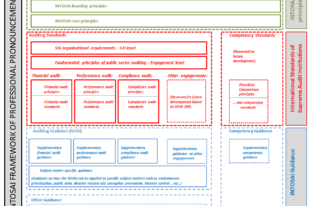The Development of Financial Audit Approaches and Impact on Efficiency and Effectiveness

Author: SAI Egypt
Introduction:
The financial statement audit, aims to provide confidence in financial statements for users’ decisions. Financial statement auditors give an independent opinion on whether financial statements are presented in accordance with the designated framework and accurately represent an entity’s financial position and activity outcomes. As organizations have developed and grown in size, so has the complexity of their operations, which have greatly influenced financial statement audit approaches. These developments do not erase the previous methods; instead, it builds upon them to make the audit process more efficient and effective.
Definition of a Financial Statement Audit
The financial statement audit is “an organized and systematic process of collecting evidence related to the results of economic activities and events as well as evaluating them objectively, in order to determine the compatibility and conformity of these results with the set standards and thus communicating all this to the concerned.”
Financial statement audits may also include an organized critical examination of internal control systems, financial systems that generate and record data, and documentation that supports the accounts and financial records of the organization. A financial audit commonly includes examination, verification and reporting; Examining the data included in the auditee’s financial records, verifying their authenticity, and submitting a report with the auditor’s technical opinion.
Financial statement audits aim to provide an independent technical opinion on an entity’s financial statements through examining and understanding the entity’s environment and its internal control system. By collecting and evaluating evidence, financial statement auditors can achieve an appropriate degree of assurance about the conformity of the financial statements with the set financial framework and established standards that they are purported to be presented, in order to provide users of the financial statements with a technical opinion as to whether the financial statements can be relied upon.
Development of Audit Approaches:
To obtain an independent technical opinion on the financial statements, financial audits may go through four stages, namely:
- The single unit audit approach,
- The balance sheet approach,
- The systems approach, and
- The risk-based approach.
Below, we explain each approach, why they evolved and improved, and then focus on the current approach, which is centered on the idea of risk.
Auditing the Financial Statements As A Single Unit Approach :
In the single unit audit approach, a significant portion of financial statement line items are sampled and verified along with their associated documents and recording procedures in the financial records. The goal is to verify the accuracy of document integrity, proper recording, appropriate categorization, and alignment with the officially issued financial statements.
A disadvantage of the single unit audit that it requires a lot of effort and there is a possibility that some financial statement line items might not be included in the audit sample. This led to the evolution of a refined approach known as the Balance Sheet Approach.
Balance Sheet Approach:
The balance sheet approach divides the audit sample into multiple groups with each group representing a sample taken from various financial statement line items. These samples are thoroughly reviewed using documentation, accounting analysis, and financial scrutiny. The objective is to ensure alignment between the issued financial statements and the balances of each individual item.
While the sample size in this approach is smaller compared to the single unit audit approach, it can still fall short, especially if a transaction is incompletely recorded, making it undetectable to the auditor. As a result, this approach has evolved into the systems approach.
Systems Approach:
The systems approach centers around an internal control system, which includes an accounting system. The approach evaluates the internal control system for each financial statements line item. When the internal control system for a line item is found to be weak, a thorough examination of documents and accounting records is conducted to ensure accuracy and alignment with the financial statement framework. Conversely, for line items with a strong internal control system, analytical procedures and a suitable sample size are used to confirm their accuracy.
While the systems-based audit approach has addressed numerous shortcomings, decreased the auditor’s workload, and enhanced audit outcomes, it has further evolved to incorporate statistical concepts into a risk-based approach.
Risk-Based Audit Approach:
The concept of certainty is a statistical concept that determines the degree of certainty required to be achieved first, followed by acceptable deviations or degrees of risk that can be tolerated. In this context, risk refers to the probability of not achieving the desired goal.
Audit risks are assessed through three sources of potential errors: the risks associated with the inherent nature of an activity (Inherent Risks), the chance that the internal control system misses detecting errors (Control Risks), and the auditor’s potential to overlook errors during examination (Risk of Non-Detection or Detection Risks).
The risk-based audit approach is built upon defining the necessary level of certainty. This, in turn, determines the acceptable range of deviations (Materiality) for each financial statement. An estimate is created for the financial statement items, outlining how much deviation is acceptable (Materiality) at the financial statement line item level. This determination considers the anticipated value of the line item and the degree of inherent and control risks it faces.
As a result, the sample size for each line item is established based on inherent risks, control risks and the anticipated value line items and the deviation acceptable (materiality),. The risk-based approach emphasizes focusing on high-risk items, which are typically assigned to more experienced auditors or subjected to more thorough examination. Meanwhile, lower risk items are examined with a lesser degree but appropriate level of scrutiny.
Development of Financial Audit Approaches and Its Role in Raising their Efficiency and Effectiveness:
Efficiency is the concept of accomplishing tasks correctly with little to no waste, effort, or energy. It concerns how well resources are used in relation to the outcomes. This involves considering how much input, such as materials, money, and people, is required to reach a specific level of output or a particular goal. Efficiency aims to attain the best outcomes while using planned resources optimally.
On the other hand, effectiveness is the concept of choosing the right tasks to accomplish. One of the main ways effectiveness can be assessed is through the criteria of goal achievement. Auditors or auditing institutions can measure effectiveness by how well organizations attain their intended goals.
The adoption of the risk-based approach in auditing has enhanced the effectiveness of audits. This approach categorizes audit areas based on the level of risk:
- Low-Risk audit areas involve repetitive, routine tasks and constitute around 80% of the audit effort.
- High-Risk audit areas are important areas that demand the expertise of highly qualified and experienced auditors due to their elevated risk level.
By planning the audit process using the risk-based approach, supreme audit institutions and public sector financial auditors can gain several advantages:
- The risk-based financial auditing approach serves as a tool for evaluating the audit strategy and refining the audit plan.
- It facilitates a clear and accurate assessment of the scope of audits, ensuring reliable evaluation of audit outcomes.
- Risk-based financial auditing enhances the efficiency and overall effectiveness of the audit process.
- This approach also safeguards auditors, acting as evidence of comprehensive audit coverage and lending reasonable confidence to the results achieved.





